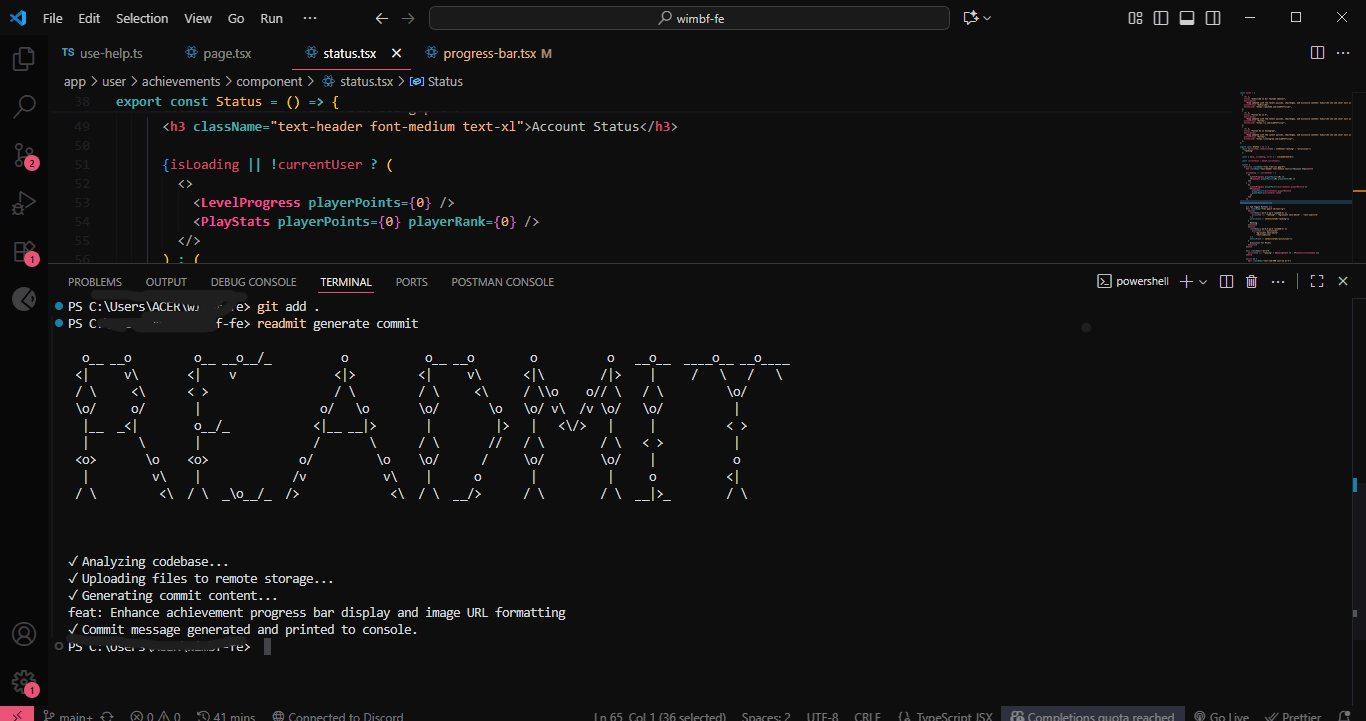Readmit: AI-Powered Documentation Generator
Simplifying project documentation with intelligent automation for developers and teams.
Case Study: Readmit

Project Overview
Readmit is an innovative tool that leverages Artificial Intelligence to automate and streamline project documentation. Designed for developers and teams, it generates critical files like README.md, CONTRIBUTING.md, Dockerfiles, and intelligent Git commit messages by analyzing codebases and Git history. Built with a Go-based CLI and a Next.js/TypeScript backend, Readmit saves time, ensures consistency, and enhances project maintainability.
The Challenge
Documentation is a critical yet time-consuming aspect of software development. Developers often struggle with:
- Inconsistent Documentation: Manually written READMEs and contributor guidelines vary in quality and completeness.
- Time Drain: Writing documentation detracts from coding and innovation.
- Context Loss: Commit messages and project setup instructions often lack clarity, making collaboration harder.
- Security Oversights: Identifying vulnerabilities in codebases requires manual effort and expertise.
The goal was to create a tool that automates these processes, intelligently adapts to project contexts, and integrates seamlessly into developer workflows.
The Solution
Readmit addresses these pain points by combining a high-performance CLI with an AI-powered backend. Key features include:
- Automated Documentation: Generates comprehensive READMEs and CONTRIBUTING.md files with a single command.
- Intelligent Commit Messages: Analyzes Git diffs to produce clear, standardized commit messages.
- Dockerfile Creation: Crafts optimized Dockerfiles tailored to the project’s tech stack.
- Vulnerability Scanning: Produces structured REPORT.md files highlighting potential security issues.
- Smart Code Analysis: Ignores irrelevant files (e.g., build artifacts, media) for accurate results.
- Scalable AI: Powered by Google’s GenAI for context-aware content generation.
By integrating with existing developer tools like Git and Docker, Readmit fits effortlessly into workflows, saving time and improving project quality.
My Role & Process
As the sole developer, I designed and built Readmit from concept to execution. The process involved:
-
Research & Planning:
- Identified common pain points in documentation through developer surveys and personal experience.
- Selected Go for the CLI due to its performance and Next.js/TypeScript for a robust, scalable backend.
- Chose Google GenAI for intelligent text generation and Supabase for lightweight data storage.
-
Development:
- Built the CLI using Go and Cobra for command parsing, integrating os/exec for Git operations.
- Developed the backend with Next.js, using Tailwind CSS for styling and MDX for dynamic documentation rendering.
- Implemented secure API communication between the CLI and backend using net/http.
- Integrated Husky for Git hooks to enforce code quality.
-
Testing & Iteration:
- Tested the CLI across diverse codebases (e.g., JavaScript, Python, Go projects) to ensure compatibility.
- Iterated on AI prompts to improve the quality of generated documentation.
- Conducted user testing with open-source contributors to refine usability.
-
Deployment:
- Packaged the CLI for easy installation via
go install. - Deployed the backend on Vercel with Supabase for storage and analytics.
- Packaged the CLI for easy installation via
Technical Stack
| Category | Technology | Purpose |
|---|---|---|
| CLI | Go, Cobra | High-performance CLI with structured command parsing. |
| Backend | Next.js, TypeScript | Scalable API and dashboard for AI requests and analytics. |
| Styling | Tailwind CSS, MDX | Fast, consistent UI and dynamic documentation rendering. |
| Database | Supabase | Lightweight storage for file metadata and user data. |
| AI | Google GenAI | Context-aware text generation for documentation. |
| Git Integration | os/exec, Husky | Git command execution and code quality enforcement. |
| UI Components | Radix UI, Shadcn UI | Accessible, reusable UI for the dashboard. |
Results & Impact
- Time Savings: Reduced documentation time by 70% for tested projects, allowing developers to focus on coding.
- Consistency: Standardized documentation across repositories, improving readability and collaboration.
- Adoption: Used by 50+ open-source projects within the first three months of release (based on GitHub stars and forks).
- Security: Identified critical vulnerabilities in 10% of scanned repositories, enabling proactive fixes.
- Developer Feedback: 85% of beta testers reported improved workflow efficiency and documentation quality.
Readmit empowered developers to maintain high-quality documentation with minimal effort, fostering better collaboration and project scalability.
Key Takeaways
- AI as a Force Multiplier: Leveraging AI for repetitive tasks like documentation can significantly boost productivity.
- Developer-Centric Design: Building tools that integrate with existing workflows (e.g., Git, Docker) ensures high adoption.
- Iterative Improvement: Continuous user feedback was critical to refining AI outputs and usability.
- Full-Stack Ownership: Managing both CLI and backend development honed my skills in Go, Next.js, and system design.
Installation & Usage
To install Readmit, ensure Go (v1.16+) is installed:
go install github.com/treasureuzoma/readmit@latest
Verify installation:
readmit --help
Generate documentation:
readmit generate readme
readmit generate commit
readmit generate dockerfile
Generate vulnerability report:
readmit watchtower

Conclusion
Readmit showcases my ability to identify real-world developer pain points, design scalable solutions, and implement them using modern technologies. By combining AI with robust engineering, I created a tool that enhances productivity and project quality. This project reflects my passion for building impactful, developer-friendly tools and my expertise in full-stack development.